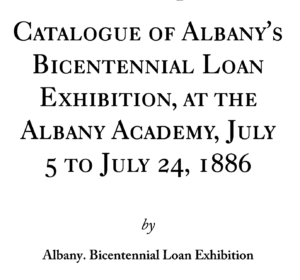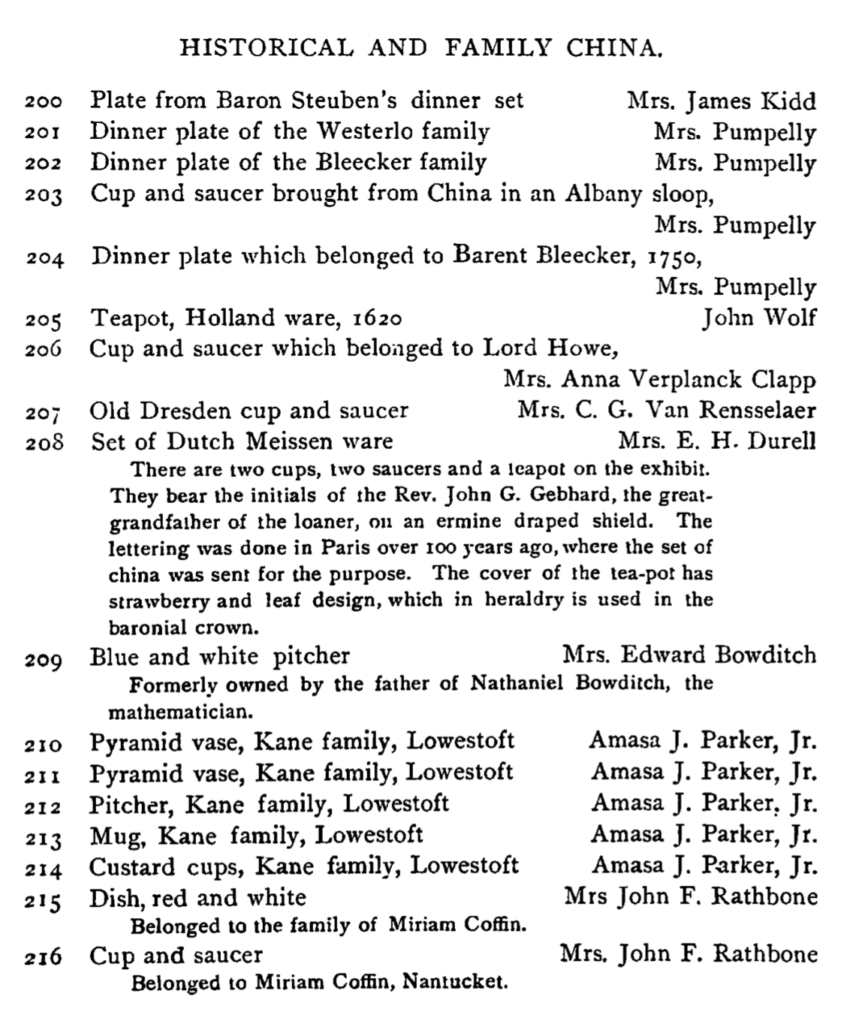Another tablet not listed in the official publication of the Albany Bi-Centennial Committee, and another one we’re not sure survives. In 1914, the Albany Argus said this had been placed on the east wall of the Albany Academy – it doesn’t appear to be there today. If anyone knows of its whereabouts, we’d be happy to hear it!
“The Bi-Centennial loan exhibition commemorative of the two hundredth anniversary of the grand of the city’s first charter was successfully held here from July 6 to July 24, 1886,” followed by a list of members of the loan commission.
The exhibition, marking the 200th anniversary of Albany’s chartering as a city, was little more than a chance for area residents to show off stuff they had collected – a show and tell without a huge amount of historical significance. But if you wanted to see Mrs. Pumpelly’s “cup and saucer brought from China in an Albany sloop,” this was the place to go.
We’ve written about the exhibition before, so we’re just going to compile our previous entries into a single post:

Back in 1886, Albany celebrated its bicentennial (dating back to its charter as a city, not its founding) with a grand exhibition held at the Albany Academy. That building, where Joseph Henry figured out inductance while teaching schoolboys, still stands in Academy Park.
This exhibition, unfortunately, had little or nothing to do with Albany itself, but was a way to show off items of supposed historic or cultural importance that were borrowed from local collections.
“The exhibition is designed especially to illustrate the growth, development and historic past of Albany . . . and to awaken an interest in the men and events which have made the city famous throughout the United States. At the same time it is not limited in scope to historic Albany. It includes any thing of interest in connection with the colonial or State governments of New York and surrounding comonwealths, and all articles of value or artistic worth . . . .”
“The exhibition is in the Albany Academy building, which, from its central location near the Capitol, is admirably adapted for such a purpose.” It was open from July 5 until July 24, Sundays excepted. Admission was twenty-five cents, or season tickets (“not transferable”) were available for $1.00.
“There are seven general departments of the exhibition proper. The Department of Pictures, Prints and Statuary occupies the east room in the second story. On account of lack of space many of the Prints have been placed in the Book and Manuscript room. The Department of Old Furniture, Ancient Dress and General Relics, the south-east room on the principal story. The Department of Ceramics, Glass and Ivories, the north-east room on the principal story. The Department of Bric-a-brac, Old Silver and Personal Ornaments, the east room on the second story. The Department of Books, Pamphlets, Maps and Manuscripts, the north-east room on the principal story. The Department of Indian Relics and the Department of Relica of the Civil War, the south room on the second story.”
You know you want to go to the Department of Old Furniture, Ancient Dress and General Relics.
The catalog of the Bicentennial Loan Exhibition explained that the purpose of the Exhibition, held in the Albany Academy building in July of 1886, was to demonstrate the growth, development, and historic past of Albany, but it quickly allowed that “it includes any thing of interest in connection with the colonial or State governments of New York and surrounding commonwealths, and all articles of value or artistic worth, such as pictures, prints, statuary, ceramics, glass, ivories, old furniture, ancient dress, Indian relics, bric-a-brac, silver, bronzes, personal ornaments, books, pamphlets, manuscripts, maps, etc.” In other words, pretty much anything that a prominent citizen of the area wanted to show they owned.

In case you thought that perhaps the mechanics of artifact borrowing was less refined in the late 19th century, consider this description from the catalog:
“All articles are moved free of expense, and by expert workmen. Receipts are given for all articles received. After the closing of the exhibition, articles belonging to parties who are out of town will be stored with the Safe Deposit Company, to await the owners’ return. A general insurance against loss or damage by fire, as far as practicable, has been effected on all articles; and a specific insurance on specific articles at the request of their owners, and at such valuation as they have desired. Watchmen are employed day and night to guard the collection. Small articles of special value are exhibited in glass cases, locked and guarded. The building itself, as is well known, is a substantial, detached, stone structure, affording a minimum of fire risk.”
Be assured, Albany’s Bicentennial Loan Exhibition of 1886 wasn’t all Native American relics. For instance, there were also Civil War relics! Rebel bullets, rebel flags, and cannon-balls, among hundreds of other odd souvenirs such as “Book, cut in twain by shell.” There was a large collection of “Oriental Ware” loaned by the American Art Association of New York City, including Japanese swords, lacquer boxes, cloisonne enamel vases, and so on.

And, historical and family china. And French ware. And Dresden work, and Delft ware.

There was a little bit to do with actual Albany history. For instance there was a copy of the original charter of the city, with the explanation that it was not actually printed until 65 years after printing was ordered, presumably because they couldn’t get the job done cheaply enough.
